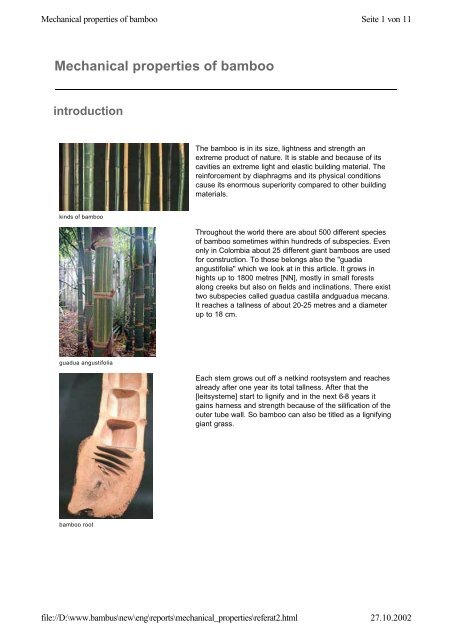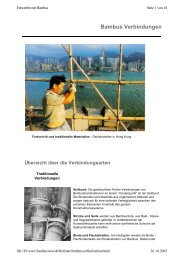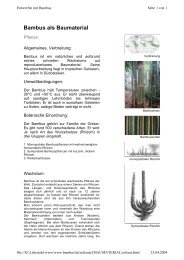Mechanical properties of bamboo
Mechanical properties of bamboo
Mechanical properties of bamboo
You also want an ePaper? Increase the reach of your titles
YUMPU automatically turns print PDFs into web optimized ePapers that Google loves.
<strong>Mechanical</strong> <strong>properties</strong> <strong>of</strong> <strong>bamboo</strong> Seite 1 von 11<br />
<strong>Mechanical</strong> <strong>properties</strong> <strong>of</strong> <strong>bamboo</strong><br />
introduction<br />
The <strong>bamboo</strong> is in its size, lightness and strength an<br />
extreme product <strong>of</strong> nature. It is stable and because <strong>of</strong> its<br />
cavities an extreme light and elastic building material. The<br />
reinforcement by diaphragms and its physical conditions<br />
cause its enormous superiority compared to other building<br />
materials.<br />
kinds <strong>of</strong> <strong>bamboo</strong><br />
Throughout the world there are about 500 different species<br />
<strong>of</strong> <strong>bamboo</strong> sometimes within hundreds <strong>of</strong> subspecies. Even<br />
only in Colombia about 25 different giant <strong>bamboo</strong>s are used<br />
for construction. To those belongs also the "guadia<br />
angustifolia" which we look at in this article. It grows in<br />
hights up to 1800 metres [NN], mostly in small forests<br />
along creeks but also on fields and inclinations. There exist<br />
two subspecies called guadua castilla andguadua mecana.<br />
It reaches a tallness <strong>of</strong> about 20-25 metres and a diameter<br />
up to 18 cm.<br />
guadua angustifolia<br />
Each stem grows out <strong>of</strong>f a netkind rootsystem and reaches<br />
already after one year its total tallness. After that the<br />
[leitsysteme] start to lignify and in the next 6-8 years it<br />
gains harness and strength because <strong>of</strong> the silification <strong>of</strong> the<br />
outer tube wall. So <strong>bamboo</strong> can also be titled as a lignifying<br />
giant grass.<br />
<strong>bamboo</strong> root<br />
file://D:\www.bambus\new\eng\reports\mechanical_<strong>properties</strong>\referat2.html 27.10.2002
<strong>Mechanical</strong> <strong>properties</strong> <strong>of</strong> <strong>bamboo</strong> Seite 2 von 11<br />
coniferous wood fibres<br />
The lignifying cell construction <strong>of</strong> the <strong>bamboo</strong> texture and<br />
its technical conditions are very similar to the original<br />
texture <strong>of</strong> wood. Whereas wood has got a hard centre<br />
[Hirnholz] and becomes weaker towardsthe outer parts<br />
[Splintholz], the <strong>bamboo</strong> is in its outer parts hard and in its<br />
inner parts weak, what causes a much more stable<br />
construction. From the inner parts <strong>of</strong> the tube towards the<br />
outer parts you can realize a continious accumulation <strong>of</strong> the<br />
[Leitbündel]. The more stable fibre structures are most<br />
dense where you find the strongest statical stress.<br />
<strong>bamboo</strong> fibres<br />
testing <strong>bamboo</strong><br />
To evaluate and compare the material conditions<br />
<strong>of</strong> <strong>bamboo</strong> the descent, the age, the humidity<br />
content and <strong>of</strong> course the diameter <strong>of</strong> the tube<br />
are <strong>of</strong> emence importance. Comparing the<br />
different results <strong>of</strong> investigation <strong>of</strong> the strength<br />
<strong>properties</strong> <strong>of</strong> <strong>bamboo</strong>, so you can see that there<br />
is a big fluctuation <strong>of</strong> the results, although they<br />
all tested the same species <strong>of</strong> <strong>bamboo</strong>, the<br />
guadua angustifolia.<br />
material testing<br />
Material parameters<br />
material parameters <strong>bamboo</strong><br />
kN/cm²<br />
elastic modulus 1900<br />
buckling (pressure II fibre)<br />
ßD with Lambda=10 5,6<br />
ßD with Lambda=56 3,9<br />
ßD with Lambda=86 2,7<br />
ßBbending 7,4<br />
ßTthrust 0,43<br />
ßZtension II fibre >=9,5<br />
Those information were given by the Stuttgarter<br />
Institut FMPA for the analysis <strong>of</strong> the Zeri-<br />
Pavillion. Unfortunately there are no information<br />
given about the specific material datas or<br />
conditions while testing the <strong>bamboo</strong>. You can<br />
find the article in the magazine "Bautechnik<br />
77,2000 No 6/7". Merely they tell us that the<br />
tubes <strong>of</strong> guadua angustifolia should have had a<br />
diameter from 10 to 14 cm and a wall thickness<br />
from 15 to 20 mm. But the delivered tubes from<br />
Colombia differed much in size and quality and<br />
so it was necessary to test them, at least 3 per<br />
delivery. Accuratwe information about lenth and<br />
size are missing.<br />
file://D:\www.bambus\new\eng\reports\mechanical_<strong>properties</strong>\referat2.html 27.10.2002
<strong>Mechanical</strong> <strong>properties</strong> <strong>of</strong> <strong>bamboo</strong> Seite 3 von 11<br />
comparison out <strong>of</strong>f DB9/97<br />
kN/cm² spruce <strong>bamboo</strong> steel<br />
St37<br />
elastic<br />
modulus<br />
compressive<br />
compressive<br />
tension<br />
strength<br />
bending<br />
strength<br />
shearing<br />
strength<br />
1100 2000 21000<br />
4,3 6,2-9,3 14<br />
8,9<br />
6,8<br />
14,8-<br />
38,4<br />
7,6-<br />
27,6<br />
16<br />
14<br />
0,7 2,0 9,2<br />
For the bending-, thrust- and tension-tests they<br />
investigated the ultimate stress limit/breaking<br />
limit, which is not to mistake for the permitted<br />
limiting stress.<br />
Dennoch ein Versuch.<br />
That chart comes from the DB, Deutsche<br />
Bauzeitung 9/97.<br />
Compressive Strength<br />
compressive<br />
strength<br />
kN/cm²<br />
parallel<br />
towards<br />
fibre<br />
vertical<br />
towards<br />
fibre<br />
tube<br />
tube<br />
d=60mm d=32mm<br />
6,36 8,63<br />
5,25-9,3<br />
Compared to bigger tubes slim tubes have got in<br />
relation to their cross section a higher<br />
compressive strength parallel and vertical to their<br />
fibre. That relatively slimmer tubes possess<br />
better material conditions is caused by the fact<br />
that bigger tubes have got a minor part <strong>of</strong> the<br />
outer skin, which is very resistent in tension. The<br />
unlimited longitudinal cleavability <strong>of</strong> the <strong>bamboo</strong><br />
tube wall inside <strong>of</strong> the internodium is caused by<br />
the strictly parallel directed fibres. Inside<br />
thenodium they cross each other in each<br />
direction. This amplification knots with its<br />
strongly silificated diaphragms increase the<br />
cleavability strength and the buckling strength <strong>of</strong><br />
the tubes. Even more we know that a cylindrical<br />
tube compared to a solid round bar possesses a<br />
much higher flexural strength.<br />
The portion <strong>of</strong> lignin affects the compressive<br />
strength. Whereas the high portion <strong>of</strong> cellulose<br />
influences the buckling and the tension strength,<br />
because it represents the building substance <strong>of</strong><br />
the <strong>bamboo</strong> fibre.<br />
Tensile strength<br />
file://D:\www.bambus\new\eng\reports\mechanical_<strong>properties</strong>\referat2.html 27.10.2002
<strong>Mechanical</strong> <strong>properties</strong> <strong>of</strong> <strong>bamboo</strong> Seite 4 von 11<br />
Tensile<br />
strength<br />
tube tube<br />
kN/cm² d=80mm d=30mm<br />
outer<br />
fibres<br />
inner<br />
fibres<br />
min=30,68 min=35,74<br />
max=32,73 max=38,43<br />
min=13,53 min=14,84<br />
max=16,33 max=19,47<br />
complete<br />
wallthickness<br />
min=16,27 min=23,25<br />
max=21,51 max=27,58<br />
Bamboo is able to resist more tensile than<br />
compression. Slim tubes are in this occasion<br />
superior, too. Inside the silificated outer skin you<br />
find axial-parallel extremly elastical fibres with a<br />
tensile strength up to 40kN/cm². As a<br />
comparison: extremly strong wood fibres can<br />
resist a tension up to 5 kN/cm² and steel St37<br />
can resist as highest possible a tension <strong>of</strong> 37<br />
kN/cm² (ultimate stress limit/breaking limit!)<br />
Elastical modulus<br />
ED<br />
elastical<br />
modulus<br />
pressure<br />
kN/cm²<br />
mm d=100 d=80 d=70<br />
min 1519 1890 1650<br />
In connection with the elastic modulus you can<br />
see an advantage in the use <strong>of</strong> slim tubes in<br />
relation to their cross section, too. The<br />
accumulation <strong>of</strong> highly strong fibres in the outer<br />
parts <strong>of</strong> the tube wall also work positive in<br />
connection with the elastical modulus like it<br />
does for the tension shear and bending strength.<br />
There exist an perfect relation <strong>of</strong> the cross<br />
section <strong>of</strong> the tube, if you fall below or above it<br />
the elastical modulus decreases (the higher the<br />
elastical modulus <strong>of</strong> the <strong>bamboo</strong>, the higher is<br />
the quality). Like the elastical modulus <strong>of</strong> solid<br />
wood the one <strong>of</strong> <strong>bamboo</strong> also decreases 5<br />
to10% with growing stress. The enormous<br />
elasticity makes <strong>bamboo</strong> to be a very useful<br />
building material in areas with high risk <strong>of</strong><br />
earthquakes. In Asia they still construct<br />
scaffolds with <strong>bamboo</strong> tubes.<br />
EZ<br />
elastical<br />
modulus<br />
tension<br />
kN/cm²<br />
mm d=90 d=80 d=70<br />
min 1700 1790 1400<br />
max 2200 2410 ?<br />
file://D:\www.bambus\new\eng\reports\mechanical_<strong>properties</strong>\referat2.html 27.10.2002
<strong>Mechanical</strong> <strong>properties</strong> <strong>of</strong> <strong>bamboo</strong> Seite 5 von 11<br />
<strong>bamboo</strong> scaffold<br />
EB<br />
elastical<br />
modulus<br />
bending<br />
kN/cm²<br />
outer<br />
fibres<br />
inner<br />
fibres<br />
complete<br />
<strong>bamboo</strong><br />
tube<br />
mm d=100 d=70 d=30<br />
1690 2270 3250<br />
1360 1890 -<br />
1700-<br />
2200<br />
Flexural (bending) strength<br />
flexural<br />
bending<br />
kN/cm²<br />
mm d=100 d=80 d=70<br />
min 1,519 1,890 1,650<br />
Atrops analysed common <strong>bamboo</strong>s: diameter <strong>of</strong><br />
tubes= 70-100 mm, wallthickness= 6-12 mm<br />
with a span <strong>of</strong> 3,60m . The elastical deflections<br />
were minimum =1/25,9 und maximum 1/16,and<br />
as an average 1/20,1 <strong>of</strong> the spans. Where a<br />
deflection in the construction was unavoidable<br />
and annoying, one could bend the recently<br />
harvested tubes so that you get a superelevation,<br />
which later will be compensated under the<br />
working load.<br />
Shearing strength<br />
shearing<br />
strength<br />
kN/cm²<br />
stem<br />
tube<br />
min=1,69 max=2,31 average=1,98<br />
min=1,47 max=2,22 average=1,67<br />
Especially for the construction <strong>of</strong> the <strong>bamboo</strong><br />
tube joinings it is important to consider the<br />
shearing resistance. The influence <strong>of</strong> the<br />
distance <strong>of</strong> the shearing surfacedecreases with<br />
growing length <strong>of</strong> shearing surface. At a wall<br />
thickness <strong>of</strong> 10 mm the shearing strength is<br />
about 11% lower than at a tube with a wall<br />
thickness <strong>of</strong> 6 mm; this could be explained by<br />
the distribution <strong>of</strong> the high-strength fibres per<br />
file://D:\www.bambus\new\eng\reports\mechanical_<strong>properties</strong>\referat2.html 27.10.2002
<strong>Mechanical</strong> <strong>properties</strong> <strong>of</strong> <strong>bamboo</strong> Seite 6 von 11<br />
cross section surface. The Values <strong>of</strong> the tables<br />
are from internodium material. The values for the<br />
nodien material are about 50 % higher.<br />
The fracture behaviour<br />
The fracture behaviour<br />
The behaviour <strong>of</strong> breaking <strong>of</strong> common building<br />
wood differs clearly from the breaking conditions<br />
<strong>of</strong> <strong>bamboo</strong>. Here you don't have a spontanious<br />
break through the whole material after the tearing<br />
<strong>of</strong> single <strong>bamboo</strong> fibres like wood does. The<br />
appearing clefts are led <strong>of</strong>f immediately in<br />
direction <strong>of</strong> the fibre and so they impair the<br />
critical region less. The energy transfer is<br />
delayed by diffusion. The distribution <strong>of</strong> the<br />
appearing longitudenal cracks all over the tube<br />
length are stopped by the enforcing knots<br />
(nodiens). Especially the pressure-, shearing-,<br />
and interlaminar strength are raised by the<br />
knots. Those symptoms are titled as increasing<br />
factor <strong>of</strong> the fracture toughness. In the research<br />
<strong>of</strong> modern compound material it is less important<br />
to prevent the formation <strong>of</strong> cracks than to<br />
counteract the distribution <strong>of</strong> the clefts by finding<br />
a suitable material construction.<br />
The fracture behaviour<br />
The fracture behaviour caused by a<br />
punch<br />
The fracture behaviour<br />
The work that is needed for the punch <strong>of</strong> a<br />
<strong>bamboo</strong> tube is nearly the same whether the<br />
punch hits the knot or the internodium. But the<br />
breaking conditions itsself are totally different. If<br />
the punch hits the knot the tube will burst in<br />
axial stripes; that means a break as a result <strong>of</strong><br />
the effort <strong>of</strong> the strength vertical to the fibres. If<br />
the punch hits the internodium you will find the<br />
actual break; that means break as a result <strong>of</strong> the<br />
effort <strong>of</strong> the tension strength in direction <strong>of</strong> the<br />
fibre. The results <strong>of</strong> the ultimate breaking punch<br />
(D=30 mm; d=4 mm) are about 2,65 mkp/cm². It<br />
is not comparable to the value <strong>of</strong> the spruce (0,5<br />
mkp/cm²) because the <strong>bamboo</strong> is <strong>of</strong> course not<br />
solid but a tube.<br />
file://D:\www.bambus\new\eng\reports\mechanical_<strong>properties</strong>\referat2.html 27.10.2002
<strong>Mechanical</strong> <strong>properties</strong> <strong>of</strong> <strong>bamboo</strong> Seite 7 von 11<br />
Examinations <strong>of</strong> the load-carrying<br />
capicity <strong>of</strong> the <strong>bamboo</strong> guadua<br />
angustifolia by Dr .Simon Eicher, Otto-<br />
Graf-Institut<br />
compressive strength fc,0<br />
compressive strength Ec,0<br />
average bending strength fm<br />
average bending strength at perfect<br />
drying<br />
5,6kN/cm²<br />
1840<br />
kN/cm²<br />
7,4 kN/cm²<br />
10 kN/cm²<br />
average elasic modulus <strong>of</strong> bending 1790kN/cm²<br />
average elasical modulus <strong>of</strong> tension 1900<br />
kN/cm²<br />
Examinations <strong>of</strong> the load-carrying capicity <strong>of</strong> the<br />
<strong>bamboo</strong> guadua angustifolia by Dr .Simon<br />
Eicher, Otto- Graf-Institut The assumptions were<br />
that the tubes had a slimness <strong>of</strong> diameter <strong>of</strong><br />
3
<strong>Mechanical</strong> <strong>properties</strong> <strong>of</strong> <strong>bamboo</strong> Seite 8 von 11<br />
(explains essentially the big differences <strong>of</strong> the<br />
results). The pressure strength increased with the<br />
age. One year old tubes resisted a pressure <strong>of</strong><br />
2,61 kN/cm² and sixth year old tubes resisted a<br />
pressure <strong>of</strong> up to 7,05 kN/cm². But in spite <strong>of</strong> all<br />
expectations a one year old resisted a tension <strong>of</strong><br />
32,06 kN/cm² and the tension strength decreased<br />
at the 5 to six year olds distinctively.<br />
§ Samples out <strong>of</strong>f 4 fixed stem hights (dark outer<br />
zone with tight fibres <strong>of</strong> about 30% with a tension<br />
strength <strong>of</strong> 20,52 kN/cm² and a white inner zone<br />
<strong>of</strong> about 70% with a tension strength <strong>of</strong> only 7,06<br />
kN/cm²; in the area <strong>of</strong> the knots (nodiens) the<br />
fibres are all different and you get an average<br />
result <strong>of</strong> about 11,75 kN/cm²)<br />
§ Modifications <strong>of</strong> the dimension throughout the<br />
moistening above the fibre-saturation point, for<br />
example by the contact <strong>of</strong> fresh cement, relate<br />
especially s<strong>of</strong>t young fibres to immense sonsume<br />
<strong>of</strong> water. Whereas older <strong>bamboo</strong> varies much<br />
less.<br />
result<br />
It is easy to<br />
recognize that<br />
the researchresults<br />
vary a<br />
lot. It is in<br />
question<br />
wether it is<br />
possible to<br />
compare<br />
them to each<br />
other.<br />
Especally<br />
because <strong>of</strong><br />
the obscurity<br />
<strong>of</strong> the<br />
examination<br />
requirements.<br />
It has to be<br />
mentioned<br />
that every<br />
result is<br />
topped by the<br />
colombian<br />
examination<br />
results,<br />
CIBAM in cooperation<br />
with<br />
the<br />
file://D:\www.bambus\new\eng\reports\mechanical_<strong>properties</strong>\referat2.html 27.10.2002
<strong>Mechanical</strong> <strong>properties</strong> <strong>of</strong> <strong>bamboo</strong> Seite 9 von 11<br />
<strong>bamboo</strong> forest<br />
Universidad<br />
del Valle, Cali<br />
(1000 m<br />
above NN)<br />
worked out a<br />
elastical<br />
modulor <strong>of</strong><br />
2.130<br />
kN/cm² ,<br />
other<br />
examinations<br />
in Medellin<br />
(1800 m) and<br />
in the c<strong>of</strong>fee<br />
region 1400-<br />
1700 m NN<br />
present even<br />
higher values.<br />
Also the<br />
examinations<br />
about<br />
pressure and<br />
tension<br />
strength differ<br />
a lot. Some<br />
examinations<br />
distinguished<br />
wethter they<br />
tested tube<br />
parts with or<br />
without<br />
nodiens or<br />
they<br />
distinguished<br />
the thickness<br />
<strong>of</strong> the tubes.<br />
Besides the<br />
hight above<br />
NN the age <strong>of</strong><br />
the tubes has<br />
got a big<br />
influence on<br />
the silification<br />
<strong>of</strong> the fibres<br />
and leads to<br />
an enormous<br />
increase <strong>of</strong><br />
the pressure<br />
strength.<br />
comparison <strong>of</strong> the examination results<br />
kN/cm²<br />
tensile<br />
strength<br />
compressive<br />
strength<br />
elastical<br />
modulus<br />
bending<br />
strength<br />
DB-magazine 14,8-38,4 6,2-9,3 2000 7,6-27,6<br />
Dr.S.Eicher - 5,6 1840 7,4-10<br />
Dr.H.Lopez 19,19 3,93 2150 -<br />
Pr<strong>of</strong>.Janssen - - 1760 14,48<br />
file://D:\www.bambus\new\eng\reports\mechanical_<strong>properties</strong>\referat2.html 27.10.2002
<strong>Mechanical</strong> <strong>properties</strong> <strong>of</strong> <strong>bamboo</strong> Seite 10 von 11<br />
To get an<br />
impression<br />
how different<br />
the results<br />
are and to<br />
make a<br />
decision<br />
wether they<br />
are<br />
comparable or<br />
not, here<br />
again a table<br />
with the most<br />
important<br />
results <strong>of</strong> the<br />
different<br />
institutes and<br />
examinations.<br />
Approximate recommended values <strong>of</strong> 'guadua angustifolia'<br />
kN/cm²<br />
elastic modulor 1800<br />
tensile strength 15,0<br />
compressive strength 3,9<br />
bending strength 7,6<br />
thrust 0,9<br />
d=12cm; d=9cm<br />
A=50cm²<br />
W=100cm³<br />
I = 700 cm4<br />
Although if<br />
you want to<br />
give<br />
approximate<br />
recommended<br />
values, you<br />
should take<br />
the lower<br />
results to<br />
stay on a safe<br />
level. Even<br />
then the<br />
<strong>bamboo</strong> still<br />
guarantees a<br />
perfect<br />
utilization <strong>of</strong><br />
that unusual<br />
building<br />
material.<br />
literature<br />
Arce-Villalobos, Oscar Antonio, -Eindhoven, Faculteit Bouwkunde, Technische Universiteit Eindhoven:<br />
Fundamentals <strong>of</strong> the Design <strong>of</strong> Bamboo Structures, Thesis Eindhoven. -Met index .ref. ISBN 90-6814-<br />
file://D:\www.bambus\new\eng\reports\mechanical_<strong>properties</strong>\referat2.html 27.10.2002
<strong>Mechanical</strong> <strong>properties</strong> <strong>of</strong> <strong>bamboo</strong> Seite 11 von 11<br />
524-X<br />
Atrops, J. L.: Elastizität und Festigkeit von Bambusrohren. Der Bauingenieur 44 (1969), Heft 6<br />
Janssen, J.A.: Bamboo in Building Structures, Dissertatie Drukkerij Wibro, Helmond, 19.Mai 1981<br />
Janssen, J.A.: Bamboo research at the Eindhoven University <strong>of</strong> Technology, Eindhoven 1990<br />
Lindemann, Josef; Steffens, Klaus: Der bambus-Pavillion zur EXPO 2000 in Hannover, Bautechnik 77<br />
(2000), Heft 6+7, Verlag Ernst & Sohn<br />
Mitteilungen des Institus für leichte Flächentragewerke IL Nr. 31 (1996), 3. Unveränd. Aufl., Karl<br />
Krämer Verlag Stuttgart.<br />
NN: Grow your own House, Verlag Vitra Design Museum, Weil a. Rhein 2000, ISBN 3-931936-25-2.<br />
Roland, Klaus, Dipl-Ing. Päd., u.a.: Wissensspeicher Holztechnik: Grundlagen, VEB Fachbuchverlag<br />
Leipzig 1988, 2. Aufl., 1988, S. 43 - 45; Dunkelberg, Klaus, "Bambus als Baust<strong>of</strong>f", in: Mitteilungen<br />
des Institus für leichte Flächentragewerke IL Nr. 31 (1992), 2. Unveränd. Aufl., Karl Krämer Verlag<br />
Stuttgart.<br />
Stamm, Jörg: Guadua im Kontext, Brief an Pr<strong>of</strong>. Wilfried Führer, Lehrstuhl für Baukonstruktion II<br />
(Tragwerklehre), RWTH Aachen.<br />
Url<br />
file://D:\www.bambus\new\eng\reports\mechanical_<strong>properties</strong>\referat2.html 27.10.2002
















